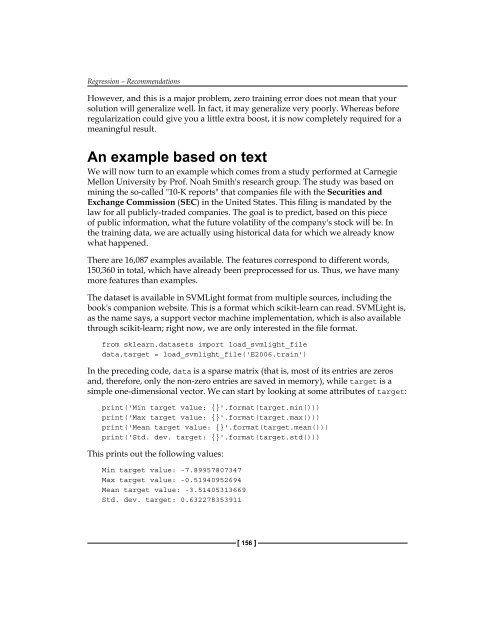1FfUrl0
1FfUrl0
1FfUrl0
Create successful ePaper yourself
Turn your PDF publications into a flip-book with our unique Google optimized e-Paper software.
Regression – Recommendations<br />
However, and this is a major problem, zero training error does not mean that your<br />
solution will generalize well. In fact, it may generalize very poorly. Whereas before<br />
regularization could give you a little extra boost, it is now completely required for a<br />
meaningful result.<br />
An example based on text<br />
We will now turn to an example which comes from a study performed at Carnegie<br />
Mellon University by Prof. Noah Smith's research group. The study was based on<br />
mining the so-called "10-K reports" that companies file with the Securities and<br />
Exchange Commission (SEC) in the United States. This filing is mandated by the<br />
law for all publicly-traded companies. The goal is to predict, based on this piece<br />
of public information, what the future volatility of the company's stock will be. In<br />
the training data, we are actually using historical data for which we already know<br />
what happened.<br />
There are 16,087 examples available. The features correspond to different words,<br />
150,360 in total, which have already been preprocessed for us. Thus, we have many<br />
more features than examples.<br />
The dataset is available in SVMLight format from multiple sources, including the<br />
book's companion website. This is a format which scikit-learn can read. SVMLight is,<br />
as the name says, a support vector machine implementation, which is also available<br />
through scikit-learn; right now, we are only interested in the file format.<br />
from sklearn.datasets import load_svmlight_file<br />
data,target = load_svmlight_file('E2006.train')<br />
In the preceding code, data is a sparse matrix (that is, most of its entries are zeros<br />
and, therefore, only the non-zero entries are saved in memory), while target is a<br />
simple one-dimensional vector. We can start by looking at some attributes of target:<br />
print('Min target value: {}'.format(target.min()))<br />
print('Max target value: {}'.format(target.max()))<br />
print('Mean target value: {}'.format(target.mean()))<br />
print('Std. dev. target: {}'.format(target.std()))<br />
This prints out the following values:<br />
Min target value: -7.89957807347<br />
Max target value: -0.51940952694<br />
Mean target value: -3.51405313669<br />
Std. dev. target: 0.632278353911<br />
[ 156 ]


